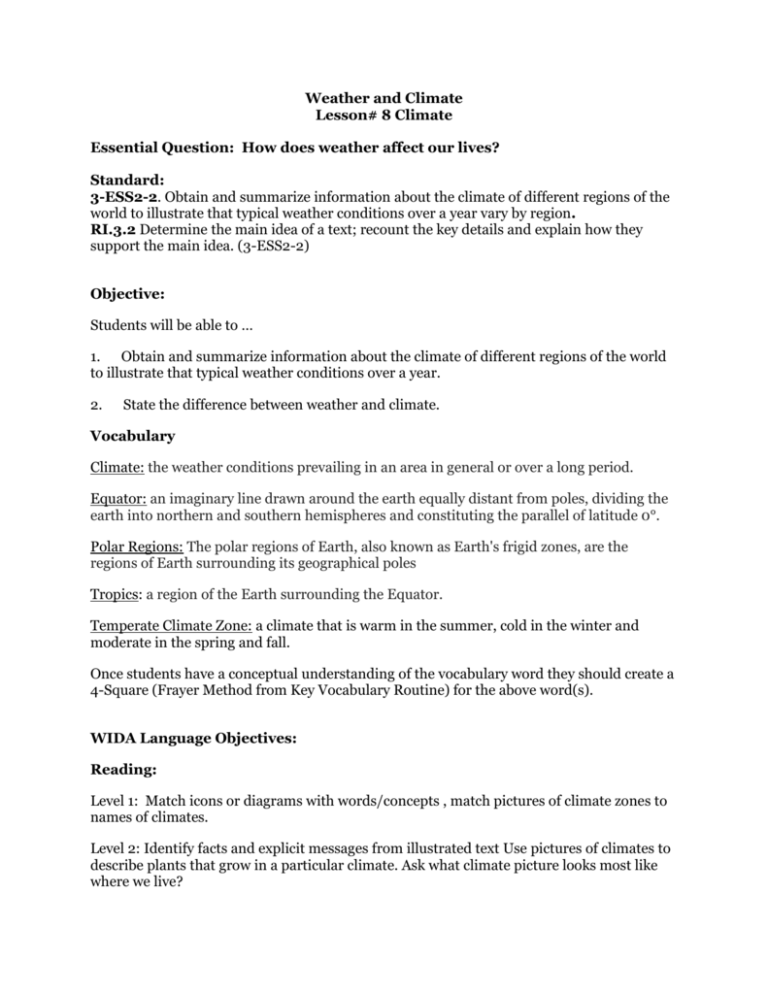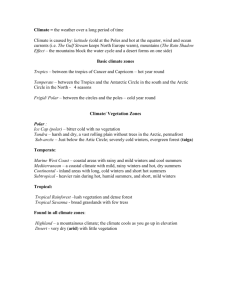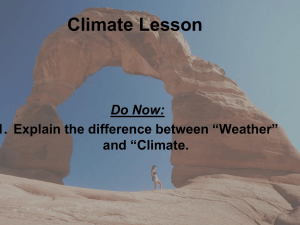Lesson 8: Climate
advertisement

Weather and Climate Lesson# 8 Climate Essential Question: How does weather affect our lives? Standard: 3-ESS2-2. Obtain and summarize information about the climate of different regions of the world to illustrate that typical weather conditions over a year vary by region. RI.3.2 Determine the main idea of a text; recount the key details and explain how they support the main idea. (3-ESS2-2) Objective: Students will be able to … 1. Obtain and summarize information about the climate of different regions of the world to illustrate that typical weather conditions over a year. 2. State the difference between weather and climate. Vocabulary Climate: the weather conditions prevailing in an area in general or over a long period. Equator: an imaginary line drawn around the earth equally distant from poles, dividing the earth into northern and southern hemispheres and constituting the parallel of latitude 0°. Polar Regions: The polar regions of Earth, also known as Earth's frigid zones, are the regions of Earth surrounding its geographical poles Tropics: a region of the Earth surrounding the Equator. Temperate Climate Zone: a climate that is warm in the summer, cold in the winter and moderate in the spring and fall. Once students have a conceptual understanding of the vocabulary word they should create a 4-Square (Frayer Method from Key Vocabulary Routine) for the above word(s). WIDA Language Objectives: Reading: Level 1: Match icons or diagrams with words/concepts , match pictures of climate zones to names of climates. Level 2: Identify facts and explicit messages from illustrated text Use pictures of climates to describe plants that grow in a particular climate. Ask what climate picture looks most like where we live? Writing: Level 1: Label objects, pictures, or diagrams from word/phrase banks label pictures of climate types Level 1: Communicate ideas by drawing Draw a picture of a temperate climate Level 2 Make comparisons using visually supported text. Look at two different pictures of climate and compare them in writing. Speaking: Level 3: Answer simple content based questions Assessment: Journal: What is the difference between weather and climate? Draw a picture of yourself in a tropical region. What might you be wearing? What is the difference between weather and climate? Resources and Materials: Item Amount Spray paint video Spray painted ball 1 (in bin) Pictures of Climate Zones 1 (in binder) Tape 1 (in bin) “Climate Zones” In Appendix Activator: 1. Hold up the spray painted ball and tell students that today they will find out why the ball looks this way. 2. Show students video of spray paint used on ball, explaining how the sun’s rays hit the equator and why the poles are colder. 3. After watching the video, show students an already completed spray paint ball so they can see details. 4. Remind students that we have been learning about different types of weather and we already know that weather is different during different seasons. An area’s weather over a long period of time is called climate. Not all places on earth have the same climate. Climate is important because only certain types of plants and animals can live in a particular climate. A region’s climate, together with its physical characteristics, determines its plant and animal life .Earth has three main climate zones—tropical, temperate, and polar. These zones can be further divided into smaller zones, each with its own typical climate. Explain why there is a difference in the area that the water covers. Ask the following questions and discuss as a class. 1. Can you compare the color to the distribution of heat from the sun? 2. How do you think this shows how much heat the earth receives from the sun? 3. Why do you think it is warmer around the equator than further south towards the Polar Regions? 4. Which areas of the planet would have the warmest seas? 5. What difference do you think this would make to the amount of water that would be evaporated from the surface of the sea? 6. Which parts of the planet do you think would have the highest rainfall and the highest temperatures? 7. Use the picture on the following page for this part, you can choose to draw the graphic on the board or show the picture on the ELMO or use the overhead transparency of the graphic. Preview the names of the climate regions and tell children they will be investigating a picture of a climate zone. Break the class up into 9 groups and have them take one of the climate pictures. Ask students to think where on the graphic their climate would be found? Explain why they think that. 8. When all the students have finished making predictions about where the climate would be located. Classmates can listen and agree or disagree with the presenters findings about where they think the climate would be located. 9. While the students are presenting the teacher can reinforce where the climates would be found and clear up misconceptions or inaccuracies that the students bring up. For instance, students may only locate the climate on the Northern Hemisphere of the globe. 10. To reinforce that different climates are found in different parts of the world, the classroom teacher should read, “Climate Zones” from Readworks.org and answer questions at the end of the selection. This reading should be completed prior to the Williams students coming in for the next lesson. The multiple choice questions at the end of the selection should be used as guiding questions during reading. Closure: Have students reflect back to the opening activity with the spray bottle. Ask for volunteers to describe how the sun hits the earth’s surface. And how that impacts climate. POLAR AND TUNDRA Polar climates are cold and dry, with long, dark winters. In the tundra (a treeless region bordering the Arctic), temperatures rise above freezing for only a few months each year. TEMPERATE FOREST Temperate climates have warm summers and cool winters with year-round rain or snow. Temperate forests are characterized by deciduous trees, which lose their leaves during the winter. MEDITERRANEAN A Mediterranean climate is found in regions bordering the Mediterranean Sea, and in Australia and California. It is characterized by hot, dry summers and cool, wet winters. DESERT Earth’s deserts are hot and dry year-round, and usually receive less than 10 in (250 mm) of rainfall a year. Deserts are often found in the center of continents, far from the sea. DRY GRASSLAND Dry grasslands are found in the center of continents where temperate variations are extreme. They have hot summers, cold winters, and little rainfall, so very few trees can grow there. SAVANNAS Tropical grasslands, such as the African savanna, lie between desert areas and tropical rainforests. The climate is hot all year, but with a distinct wet season and dry season. TROPICAL RAINFOREST Tropical rainforests are found in regions near the equator. Here, the climate is hot and wet all year, with temperatures remaining at around 80–82ºF (27–28ºC).











